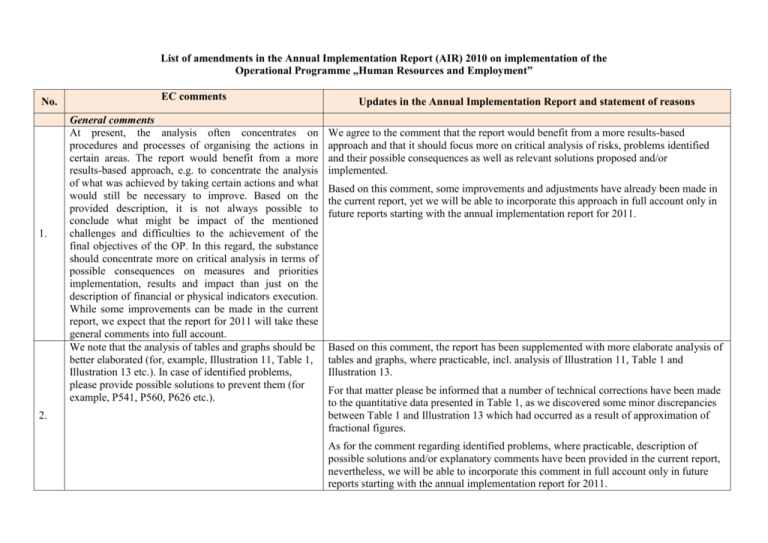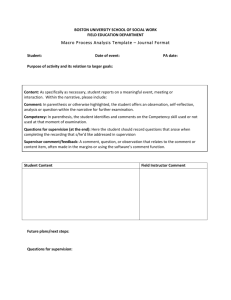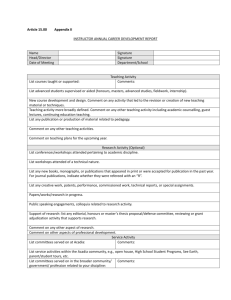List of amendments in the Annual Implementation Report (AIR) 2010
advertisement

List of amendments in the Annual Implementation Report (AIR) 2010 on implementation of the Operational Programme „Human Resources and Employment” No. 1. 2. EC comments General comments At present, the analysis often concentrates on procedures and processes of organising the actions in certain areas. The report would benefit from a more results-based approach, e.g. to concentrate the analysis of what was achieved by taking certain actions and what would still be necessary to improve. Based on the provided description, it is not always possible to conclude what might be impact of the mentioned challenges and difficulties to the achievement of the final objectives of the OP. In this regard, the substance should concentrate more on critical analysis in terms of possible consequences on measures and priorities implementation, results and impact than just on the description of financial or physical indicators execution. While some improvements can be made in the current report, we expect that the report for 2011 will take these general comments into full account. We note that the analysis of tables and graphs should be better elaborated (for, example, Illustration 11, Table 1, Illustration 13 etc.). In case of identified problems, please provide possible solutions to prevent them (for example, P541, P560, P626 etc.). Updates in the Annual Implementation Report and statement of reasons We agree to the comment that the report would benefit from a more results-based approach and that it should focus more on critical analysis of risks, problems identified and their possible consequences as well as relevant solutions proposed and/or implemented. Based on this comment, some improvements and adjustments have already been made in the current report, yet we will be able to incorporate this approach in full account only in future reports starting with the annual implementation report for 2011. Based on this comment, the report has been supplemented with more elaborate analysis of tables and graphs, where practicable, incl. analysis of Illustration 11, Table 1 and Illustration 13. For that matter please be informed that a number of technical corrections have been made to the quantitative data presented in Table 1, as we discovered some minor discrepancies between Table 1 and Illustration 13 which had occurred as a result of approximation of fractional figures. As for the comment regarding identified problems, where practicable, description of possible solutions and/or explanatory comments have been provided in the current report, nevertheless, we will be able to incorporate this comment in full account only in future reports starting with the annual implementation report for 2011. 2 Please ensure that each sub-chapter is equally structured. At present, several sub-chapters under each chapter use different methodological approaches that do 3. not allow to observe complete picture as some information seems missing or is too general/too detailed (for example, sub-chapter 2.1.6., chapter 2.4. etc.). We invite you to include additional chapters on innovative activities and trans-national and/or interregional actions as required by Article 10 of Regulation 4. No. 1081/2006. Current AIR includes some scattered references to the activities across the AIR that does not provide clear overview on the subject. Please ensure smooth readability of the AIR by avoiding duplication of paragraphs (P) and mistakes (for 5. example, P329 (duplication), P382 (duplication with second sentence of P381), P405 partly duplicates P404, P593 duplicates P591 etc.). Specific comments Sub-chapter on "Signed Contracts by Dimension Codes" 1. - Please provide information on reasons for underachievement in case of activities (Illustration 11). Although the AIR provides extensive analysis on participants by gender, disability and employability, we would like to see more detailed information on breakdown of participants also by educational attainment as presented information does not give full picture on the subject (Annex XXIII of Regulation No. 2. 1828/2006). Additional information on involvement of minorities and migrants also would be welcomed (for example, by mentioning in what type of activities they are participating). Regarding less active target groups mentioned at the end of P88, we would appreciate more explanatory information on measures planned for their activation. Some improvements have been made in the current report, for example, see chapter 2.4 regarding structural reforms which has been supplemented with additional information to ensure full picture of the reforms undertaken in all spheres of public administration relevant in the context of the OP “Human Resources and Employment”. We acknowledge that, as far as possible and/or applicable, this comment will be adhered to also in the preparation of future reports, incl. the annual implementation report for 2011. Please see the amendments made in chapter 2.1.4 of the current report where, based on this comment, additional information has been provided on both innovative activities and trans-national and/or inter-regional actions, incl. information on the relevant actions taken within the different priorities/activities of the OP “Human Resources and Employment”. Based on this comment, technical amendments have been made in all of the paragraphs where problems with duplication were identified. Please see amendments in the sub-chapter on “Signed Contracts by Dimension Codes” (page 21), where supplementary information on the reasons for underachievement in some of the activities has been provided. Please see amendments in the sub-chapter on support for target groups (pages 29-34) where supplementary information/analysis has been provided on both the breakdown of participants by educational attainment as well as on the involvement of minorities and migrants, incl. data on their participation in different activities. As for the comment regarding the involvement of less active target groups, please see also the additional information provided in P129 (page 34). 3 3. 4. 5. 6. Sub-chapter on "Involvement of Social partners" and "Promotion of Partnership, Involvement of NGOs" - We advise you to combine both sub-chapters as they, partially, overlap with each other due to the nature of information. We would also like to ask you to include information on the total funding available for the partners (financing is mentioned only in case of some activities). Additional attention should be paid to the structure and relevance of the analysis. At present, the analysis provides very detailed information on partnership in activities under responsibility of Ministry of Welfare and Ministry of Education and Science compared to activities under responsibility of Ministry of Economics and Ministry of Environmental Protection and Regional Development that contains very brief and general description. Therefore, the overall picture of partners' involvement in different stages of implementation of EU Structural Funds is incomplete. Based on this comment, both sub-chapters have been merged and supplemented with additional information, where necessary, incl., with information on the total funding available for the partners within the various activities of the OP “Human Resources and Employment”. Please see the joint amended sub-chapter “Involvement of Social Partners, Promotion of Partnership and Involvement of NGOs” of the current report on pages 34-42. Chapter 2.1.4. - Please elaborate more detailed analysis Please see the amendments made in Chapter 2.1.4, based on this comment, incl. the on actions related to the European Employment Strategy supplementary information provided on actions related to the European Employment within the framework of the National Reform Strategy as planned in the framework of the National Reform Programme (pages 46-48). Programme (Article 4 (1) of Regulation 1081/2006). Chapter 2.2. - We invite you to provide an information on the specific cases of breaching community law mentioned in P238 and measures taken to deal with them in accordance with Article 67 (2)(f) Regulation No. 1083/2006. Please see amendments in Chapter 2.2, which has been supplemented based on the information provided by the Public Monitoring Bureau (see page 77). Chapter 2.4. - Please ensure unified approach in description of structural reforms in each sector. At present, information on reforms in public sector and health care is very general compared to analysis Please see amendments in Chapter 2.4.1 which has been supplemented with additional information on the structural reforms undertaken in the different sectors of public administration relevant in the context of the OP “Human Resources and Employment”, incl. structural reforms in the public sector in general as well as reforms in the health 4 provided on reforms in education and employment. In sector. case of some sectors, no information on planned activities has been provided at all. It is worth to mention in Chapter 2.4.1 that the reforms and EU Funds are interacting with each other - ESF provides significant support to implementation of the reforms as it is shown in following sub-chapters. 7. 8. 9. Chapter 2.8.5. - We invite you to provide more substantial and legally justified information regarding statement in the last sentence of P433: "..taču vienotie iepirkumi vienlaicīgi ļauj ietaupīt resursus un spēj nodrošināt iegādāto komponentu savietojamību". Chapter 3 - Please add supplementing information on statements made in the analysis (for example, P508 will the activities be implemented at the later stage? P520 – why activity was not popular? P5.4.1. - What are the causes for slow implementation? etc.). Information on problems recognised during the implementation stage and relevant solutions would also make a significant complement to the analysis. Please see the amendments made in chapter 2.8.5 based on the supplementary information and clarifications provided by the Public Monitoring Bureau (see pages 122123). Chapter 4 - We invite you to provide more substantial information on priority sectors mentioned in P580, incl., information whether any other documents identifying priority sectors in Latvia are used as a supporting document to attract EU funding in case of other activities. Please see amendments in chapter 4 where, based on this comment, additional information has been provided on the priority sectors defined in the report prepared by the Ministry of Economics on mid-term economic recovery policy areas that was approved by the Cabinet of Ministers on November 10, 2009 (please see page 155 of the current report). Please see the amendments made in chapter 3, where supplementary information has been provided in the paragraphs identified in this comment. In addition, we acknowledge that in order to improve analysis of problems identified during the implementation and the relevant solutions, this comment will be taken into full account in the preparation of future reports, incl. annual implementation report for 2011. As for the use of any other documents identifying priority sectors to attract EU funding, it should be noted that so far no other policy planning documents have been approved that would define priority sectors, except for the above-mentioned informative report to the Cabinet prepared by the Ministry of Economics on priority areas for mid-term economic recovery policy. Therefore no amendments have been made in the current report to this regard. 5 10. Annex 4 - Referring to P73, please provide more detailed information on achievement of indicators as required by Annex XVIII of Regulation No. 1828/2006. At present, many indicators are missing any description, while information on several indicators is either repetitive or very general. Please include information on possible risks to achieve underperformed indicators. Please see amendments in Annex 4, which has been supplemented, based on this comment, namely, for each indicator a descriptive / explanatory comment has been provided incl., where applicable, information on the possible risks which could affect the achievement of underperformed indicators. This comment will be taken on board also when preparing annual implementation reports for the next reporting periods where we will attempt to ensure more detailed analysis of the progress achieved in reaching the set indicators as well as reasons for underachievement and relevant solutions proposed or taken for addressing them. In addition, please note that technical corrections were made regarding the actual progress achieved in reaching the influence indicator “Reduction of the number of casualties of lethal labour accidents (number of lethal labour accidents per 100 thousand employees)” due to technical calculation error made in the previous version of Annex 4.




